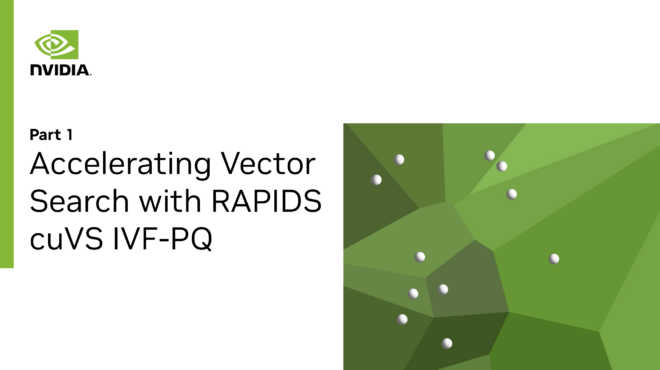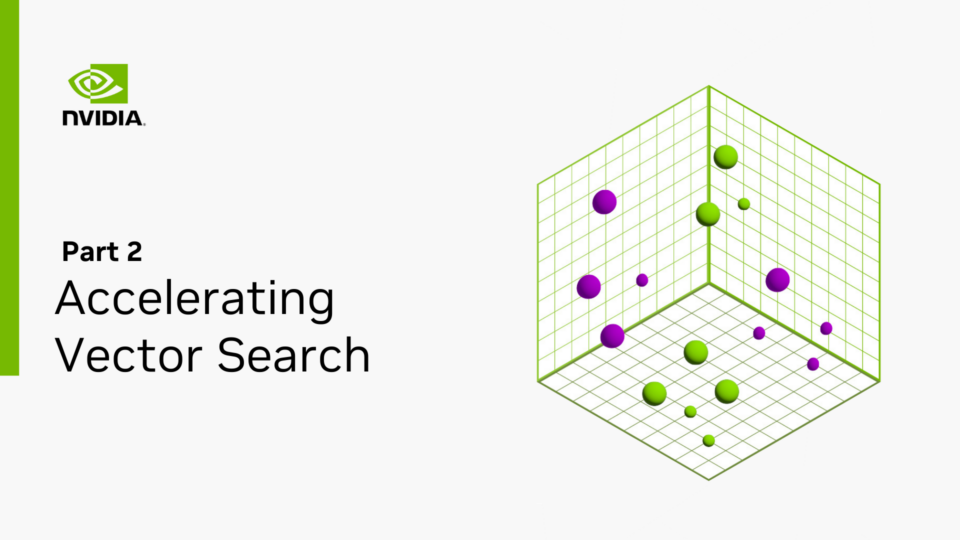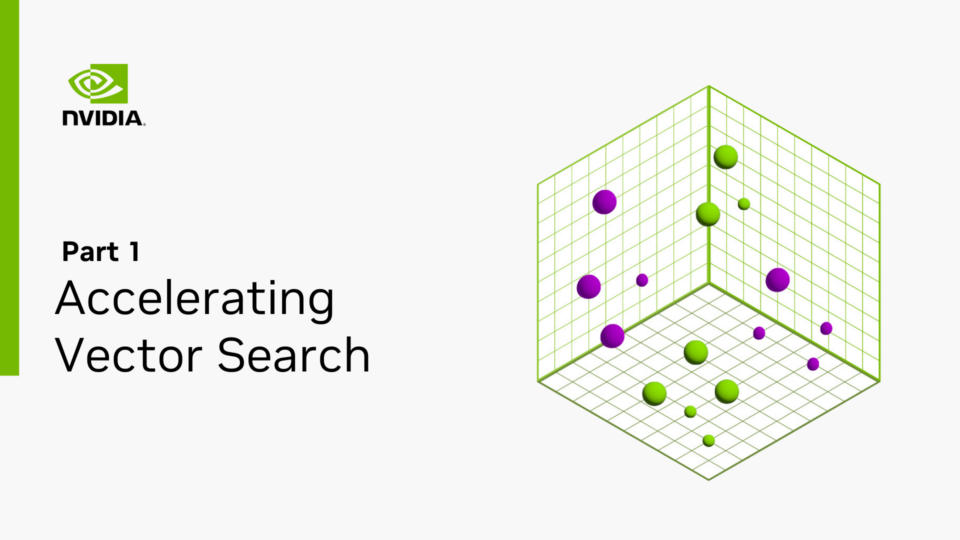AI-powered search demands high-performance indexing, low-latency retrieval, and seamless scalability. NVIDIA cuVS brings GPU-accelerated vector search and clustering to developers and data scientists, enabling faster index builds, real-time updates, and efficient large-scale search for applications like retrieval-augmented generation (RAG), recommendation systems, exploratory data analysis, and anomaly detection.
The latest cuVS release introduces optimized indexing algorithms, expanded language support, and deeper integrations with NVIDIA partners such as Meta FAISS and Google Cloud AlloyDB and Vertex AI, as well as Milvus, Apache Lucene, Elasticsearch, OpenSearch, Weaviate, Kinetica, and more.
Whether you’re enhancing search in existing vector databases or building custom AI-powered retrieval systems, cuVS provides the speed, flexibility, and ease of integration needed to push performance to the next level. This post introduces the latest features and how they unlock AI-driven search at scale, along with new benchmarks.
Building indexes faster on the GPU
As the NVIDIA cuVS team strives to provide the most widely used indexing algorithms, DiskANN, and more specifically its graph-based algorithm called Vamana, can now be built on the GPU for a 40x or greater speedup over the CPU. NVIDIA is collaborating with Microsoft to bring the hyperscalable DiskANN/Vamana algorithm to the GPU for solving important customer use cases.
In the quest to make accelerated vector search available to all, NVIDIA is also partnering with hyperscaler transactional databases like Google Cloud and Oracle.
Google Cloud AlloyDB is working to bring state-of-the-art index build performance for HNSW with 9x speedup over pgvector on the CPU. Oracle has prototyped cuVS integration with AI Vector Search in Oracle Database 23ai to help accelerate HNSW index builds and is seeing a 5x speedup end-to-end.
Weaviate recently integrated cuVS to optimize vector search on the GPU. Initial tests show this integration slashes index build times by 8x using CAGRA, a GPU-native vector indexing method, on GPUs. This provides seamless deployment to CPUs for fast HNSW-powered search.
NVIDIA has been working diligently with SearchScale to integrate cuVS into Apache Lucene, a widely used open-source software library for full-text search, to accelerate index builds on the GPU by 40x. Along with Lucene comes Apache Solr with 6x end-to-end index build speedup over CPU. The NVIDIA cuVS team is looking forward to OpenSearch 3.0, which will use cuVS for GPU-accelerated index building, and demonstrate up to 9.4x faster index build times. To round out the Lucene story, an Elasticsearch plugin will bring cuVS capabilities to the entire ecosystem.
Storage partners are also jumping on board, with DDN accelerating AI workloads in Milvus with 22x faster index build using CAGRA. cuVS and NeMo retriever multimodal PDF extraction pipeline are being integrated into DDN Infinia to process petabyte-scale data, creating an end-to-end one-click high-performance RAG pipeline.
CPU and GPU interoperability
In many RAG workflows, latency for LLM inferencing will swamp latency for vector database querying. However, data volumes are increasing rapidly in such workflows, creating long index build times and increasing costs. At this scale, an ideal solution is to use GPUs for index builds and CPUs for the index search.
cuVS offers indexes that are interoperable between GPU and CPU, enabling AI systems to use existing CPU infrastructure for searching while taking advantage of modern GPU infrastructure for index building. Index interoperability offers AI applications faster index build times with potentially lower costs while preserving vector search on a CPU-powered vector database.

This index interoperability between CPU and GPU is one of the most popular features of cuVS. While the library primarily targets GPU-accelerated capabilities, a trend is emerging for building indexes on the GPU and converting them to compatible formats for search with algorithms on the CPU.
For example, cuVS can build a CAGRA graph much faster on the GPU and convert it to a proper HNSW graph to search on the CPU. cuVS offers similar support for building the popular DiskANN/Vamana index on the GPU and converting to a format compatible with its CPU counterpart for search.
For more direct and comprehensive CPU and GPU interoperability, it’s recommended to leverage cuVS indexes through the Meta FAISS library. FAISS pioneered vector search on the GPU, and the library is now using cuVS to accelerate index builds on the CPU by 12x while accelerating their classical GPU indexes by 8x or more. FAISS recently released new Python packages with cuVS support enabled.
Reduced precision, quantization, and improved language support
cuVS recently added Rust, Go, and Java APIs, making accelerated vector search even more widely accessible. These new APIs can also be built from the same code base available through GitHub. The team continues to improve these APIs, adding more index types and advanced features like clustering and preprocessing.
Binary and scalar quantization are common preprocessing techniques to shrink the footprint of vectors by 4x and 32x, respectively (from 32-bit floating point types). They are both supported in cuVS and demonstrate 4x and 20x performance improvement over the CPU, respectively.
When it comes to special-purpose vector databases, Milvus was among the first to adopt cuVS. They continue to improve their support for GPUs with new capabilities, such as the new CAGRA capability to build a graph directly on binary quantized vectors.
Accelerating high-throughput search
cuVS now offers a first-class dynamic batching API, which can improve latencies for high-volume online search on the GPU by up to 10x. High-volume online search throughput, such as trading and ads serving pipelines, can be improved by 8x or more while maintaining low one-at-a-time latencies using the new CAGRA persistent search feature. Microsoft Advertising is exploring the integration of the cuVS CAGRA search algorithm for this purpose.
Thanks to recent improvements to the prefiltering capability of the native GPU-accelerated graph-based CAGRA algorithm, it now achieves high recall even when most of the vectors (99%, for example) have been excluded from the search results.
Aside from being a core computation in the CAGRA algorithm, kNN graphs are widely used in data mining. They are core building blocks in manifold learning techniques for reducing dimensionality and clustering techniques for data analysis. Recent updates to the nn-descent nearest neighbors algorithm in cuVS are enabling kNN graphs to be constructed out-of-core. This means that your dataset needs only be confined to the amount of RAM memory in your system. It enables iterative near-real-time exploratory data analysis workflows at massive scale, which is not tractable for the CPU.
You can experience these speedups yourself using the UMAP algorithm in RAPIDS cuML, actively used by companies like Adoreboard and Studentpulse. Topic modeling is a common use for manifold learning and clustering techniques, and the BERTopic library makes large-scale workflows tractable on the GPU. Single-cell genomics analysis is another domain, and rapids-singlecell leverages both cuVS and cuML to achieve groundbreaking performance.
Get started with NVIDIA cuVS
NVIDIA cuVS continues to redefine GPU-accelerated vector search, offering innovations that optimize performance, reduce costs, and streamline AI application development. With new features, expanded language support, and deeper integrations across the AI ecosystem, cuVS empowers organizations to scale their search and retrieval workloads like never before.
Get started with the rapidsai / cuvs GitHub library, including end-to-end examples and an automated tuning guide. You can also use cuVS Bench to benchmark and compare ANN search implementations across GPU and CPU environments.
cuVS is meant to be used either as a standalone library or through an integration such as FAISS, Milvus, Weaviate, Lucene, Kinetica, and more. Stay tuned for further developments as NVIDIA continues to push the frontier of AI-driven search.










